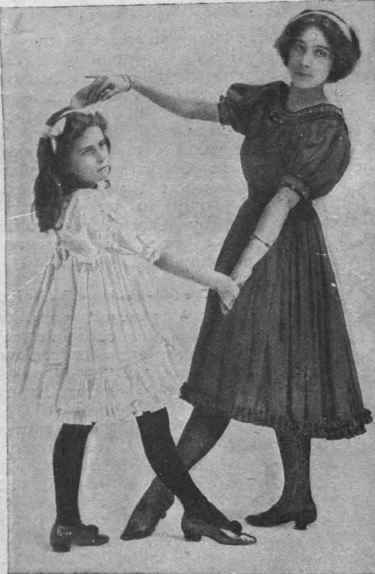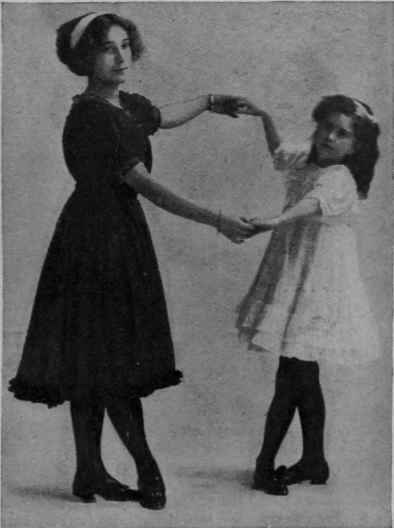Dancing. A Lesson In The Reverse
Description
This section is from "Every Woman's Encyclopaedia". Also available from Amazon: Every Woman's Encyclopaedia.
Dancing. A Lesson In The Reverse
Principal of The Physical Training College, South Kensington
Hints about "Waltzing - The Backing Step - The Best Way to Teach a Child
Before giving a detailed description of the reverse, it may be advisable to say a little more about the waltz in its more advanced stages, for reversing should never be attempted until the waltz is absolutely mastered. That means until the pupil has reached such a stage that she can waltz and "back" with perfect ease, up to time, without thinking about the steps or the position of her body.

Fig. I. The first step. The pupil slides the right foot forward outside her instructor's feet. The instructor moves her left foot Photos] forward between the pupil's feet. [M. Facolette
That is the pitfall open to so many beginners, and the cause of many good waltzers spoiling their own dancing. Directly a beginner imagines she can waltz she burns to learn the reverse. It is absolute folly to teach her. The reverse is not difficult - far from it; but most people believe it is, for this reason: they start learning to reverse before they really know how to waltz. In consequence, they mix the two steps hopelessly. The result is, the waltz step spoilt and complete failure to learn the reverse. To teach a beginner the reverse is like putting a novice at riding on a buck-jumper, and has quite as disastrous results.
The general dancing public look upon good reversers with admiration akin to awe.
They believe these geniuses are doing something terribly difficult. But they are not. They have merely followed the sensible course of learning to walk before they run, which, in this case, means perfecting the waltz before they attempted the reverse And th.3 result is admirable.
From the directions given regarding a child's first waltz lesson (see page 1316), it will easily be gathered that considerable time and practice will be needed before sufficient proficiency is obtained to warrant the reverse being taught. There are several small but important details which will help greatly in teaching a child.
The six waltz steps should be practised very slowly, with the teacher holding both the pupil's hands, and raising her slightly on the sixth step to help her in turning. It is a great mistake to try to waltz quickly at first. Once the step is perfect, speed follows naturally and quickly. But a step done too fast in the early stages usually becomes slipshod and incorrect, and is very hard to alter.
Make the child count for herself, aloud, as she does each step. This helps to fix the steps, and their sequence, in her mind. When dancing slowly she will count " one ' to each step, but as the speed increases this becomes awkward. She must then divide the six beats into half, and count "one" to the first three and "two" to the last three. Thus she will count "one" and "two" on the long steps in the waltz. "One" will always mean that her right foot slides forward; "two" that her left slides round. This will be found a great help. It not only induces a beginner to shorten the unimportant steps, but encourages her to lay the necessary stress on the two long slides, which is the secret of perfect waltzing.
Behind her right, and the instructor slides her right foot obliquely

Fig. 2. To make the second step the pupil draws her left foot round outside the pupil's feet
A waltz that is a series of six even, stodgy steps, however correct they may be, is most ugly to watch. It needs the swing and accent given by the varying length of the steps to make a perfect waltz.
Once the six steps are perfectly known, the teacher must insist on the pupil lengthening the first and fourth steps, and shortening the second and third, fifth and sixth, so that when the waltz is danced up to time the shorter steps become practically invisible. The waltz does consist of six steps, not two. The shorter ones are always there, at the right time, in the right place; but they should not be made prominent. A beginner should be carefully taught the detail of the steps, or when she waltzes fast she may think there are only two.
It is an excellent plan to make a beginner waltz alone. Start her in the correct position, and make her do the steps exactly as if her partner stood in front of her. This will quickly show if she really makes a complete circle. It is such a common fault with beginners to go only three-quarters round, and thus make each circle shorter than the preceding ones.

Fig. 3. The third step. The pupil rises on both toes, and drops her left foot in front of her right in the fifth position. The instructor closes her left foot behind her right

Fig. 4. The fourth step. The pupil slides her left foot forward inside her instructor's feet. The latter slides her right foot forward outside the pupil's feet
When the child begins to know the step, it is time to hold her properly and teach her the "backing" step. And here much can be done to help or hinder good waltzing. The gentleman puts his right arm under her left, and rests his hand flat against her back between her shoulder-blades. Never hold a partner round her waist. This is not only most uncomfortable, but it pulls her off her feet and balance, and throws her body - above the waist - backwards. Thus the weight is all in the wrong place. By putting his hand flat between her shoulders the gentleman helps her to lean forward as she dances, and also has much greater control, and can steer with perfect ease. It is necessary to impress on a beginner the need to throw her weight forward with each step.
Continue to:


